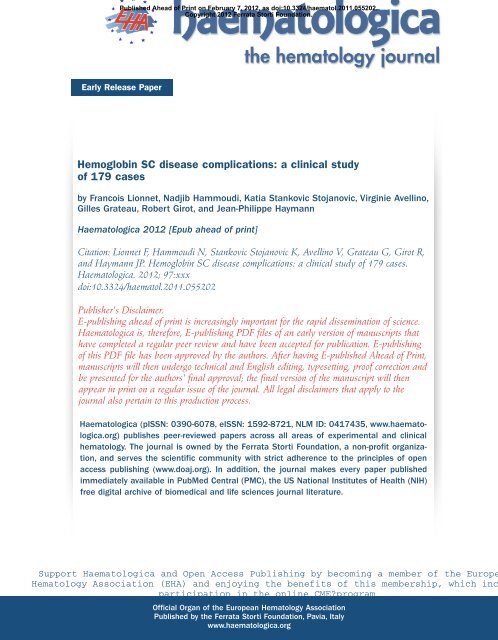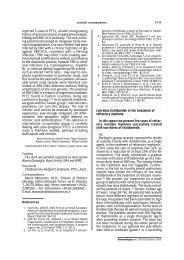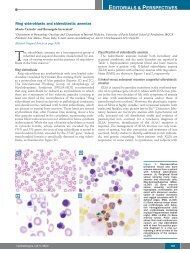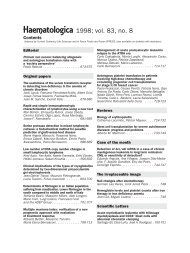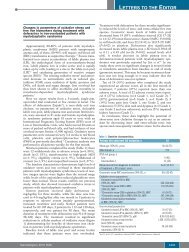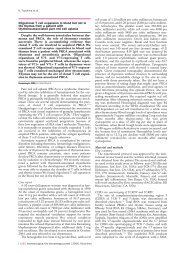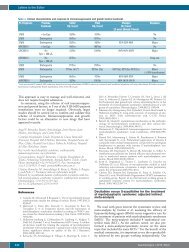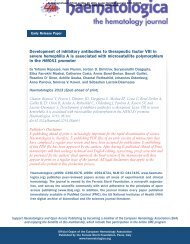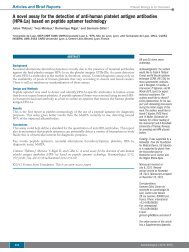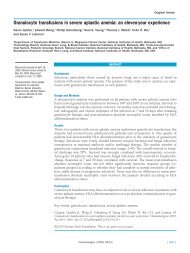SC revised haematologica janv 12
SC revised haematologica janv 12
SC revised haematologica janv 12
You also want an ePaper? Increase the reach of your titles
YUMPU automatically turns print PDFs into web optimized ePapers that Google loves.
Published Ahead of Print on February 7, 20<strong>12</strong>, as doi:10.3324/haematol.2011.055202.<br />
Copyright 20<strong>12</strong> Ferrata Storti Foundation.<br />
Early Release Paper<br />
Hemoglobin <strong>SC</strong> disease complications: a clinical study<br />
of 179 cases<br />
by Francois Lionnet, Nadjib Hammoudi, Katia Stankovic Stojanovic, Virginie Avellino,<br />
Gilles Grateau, Robert Girot, and Jean-Philippe Haymann<br />
Haematologica 20<strong>12</strong> [Epub ahead of print]<br />
Citation: Lionnet F, Hammoudi N, Stankovic Stojanovic K, Avellino V, Grateau G, Girot R,<br />
and Haymann JP. Hemoglobin <strong>SC</strong> disease complications: a clinical study of 179 cases.<br />
Haematologica. 20<strong>12</strong>; 97:xxx<br />
doi:10.3324/haematol.2011.055202<br />
Publisher's Disclaimer.<br />
E-publishing ahead of print is increasingly important for the rapid dissemination of science.<br />
Haematologica is, therefore, E-publishing PDF files of an early version of manuscripts that<br />
have completed a regular peer review and have been accepted for publication. E-publishing<br />
of this PDF file has been approved by the authors. After having E-published Ahead of Print,<br />
manuscripts will then undergo technical and English editing, typesetting, proof correction and<br />
be presented for the authors' final approval; the final version of the manuscript will then<br />
appear in print on a regular issue of the journal. All legal disclaimers that apply to the<br />
journal also pertain to this production process.<br />
Haematologica (pISSN: 0390-6078, eISSN: 1592-8721, NLM ID: 0417435, www.<strong>haematologica</strong>.org)<br />
publishes peer-reviewed papers across all areas of experimental and clinical<br />
hematology. The journal is owned by the Ferrata Storti Foundation, a non-profit organization,<br />
and serves the scientific community with strict adherence to the principles of open<br />
access publishing (www.doaj.org). In addition, the journal makes every paper published<br />
immediately available in PubMed Central (PMC), the US National Institutes of Health (NIH)<br />
free digital archive of biomedical and life sciences journal literature.<br />
Support Haematologica and Open Access Publishing by becoming a member of the Europe<br />
Hematology Association (EHA) and enjoying the benefits of this membership, which inc<br />
participation in the online CME?program<br />
Official Organ of the European Hematology Association<br />
Published by the Ferrata Storti Foundation, Pavia, Italy<br />
www.<strong>haematologica</strong>.org
Hemoglobin <strong>SC</strong> disease complications: a clinical study of 179 cases<br />
Running title: Hemoglobin <strong>SC</strong> disease; F. Lionnet et al<br />
François Lionnet, 1 Nadjib Hammoudi, 2 Katia Stankovic Stojanovic, 1 Virginie Avellino, 1 Gilles<br />
Grateau, 3 Robert Girot, 4 and Jean-Philippe Haymann 5<br />
1 Service de Médecine Interne, Hôpital Tenon, AP-HP, Paris; Centre de Référence de la<br />
drépanocytose, France; 2 Service de Cardiologie, Hôpital Pitié-Salpêtrière, Paris; Université<br />
Pierre et Marie Curie Paris 6, France; 3 Service de Médecine Interne, Hôpital Tenon, AP-HP,<br />
Paris; Centre de Référence de la drépanocytose; Université Pierre et Marie Curie Paris 6,<br />
France; 4 Service d’Hématologie Biologique, Hôpital Tenon, AP-HP, Paris; Centre de<br />
Référence de la drépanocytose; Université Pierre et Marie Curie Paris 6, France,<br />
and 5 Service des Explorations Fonctionnelles, Hôpital Tenon, AP-HP, Paris,<br />
Université Pierre et Marie Curie Paris 6, INSERM, UMRS-702, France<br />
Correspondence<br />
François Lionnet, Hôpital Tenon, 4 rue de la Chine, 75020, Paris, France.<br />
Phone: international +33.156016217.Fax: international +33.156018407.<br />
E-mail: francois.lionnet@tnn.aphp.fr<br />
Key words: hemoglobin <strong>SC</strong> disease, sickle cell anemia, nephropathy, pulmonary arterial<br />
hypertention, retinopathy, hyperviscosity, otologic disorders, anemia, phlebotomy.<br />
Funding: No.<br />
DOI: 10.3324/haematol.2011.055202<br />
Conflict of Interest: All authors reported that they have no conflicts of interest.<br />
Authorship: All authors had access to the data and participated in writing the manuscript.
Abstract<br />
Background. Hemoglobin <strong>SC</strong> disease is one of the most frequent hemoglobinopathy. Surprisingly, few<br />
studies were dedicated to this disease, currently considered as a mild variant of homozygous sickle cell<br />
disease. The aim of this study was to update our knowledge about hemoglobin <strong>SC</strong> disease.<br />
Design and Methods. We conducted this study in a monocentric series of 179 patients. Clinical and<br />
biological data were collected, with a special concern for the assessment of pulmonary arterial hypertension<br />
and nephropathy.<br />
Results. Hemoglobin <strong>SC</strong> diagnosis was delayed and performed in adulthood in 29% of cases. Hospitalized<br />
painful vasoocclusive crisis, acute chest syndrome and priapism had a prevalence of 36%, 20% and 20%<br />
respectively. The most common chronic organ complications were retinopathy and sensorineural otologic<br />
disorders occurring in 70% and 29% of cases. Indeed, prevalence of complications reported in homozygous<br />
sickle cell disease such as nephropathy, suspicion of pulmonary hypertension, strokes and leg ulcers was<br />
rather low (13%, 4% and 1% respectively). Phlebotomy performed in 36% of this population (baseline<br />
hemoglobin level: 11.5 g/dL), prevented acute events recurrence in 71% of cases.<br />
Conclusions. Our data suggest that hemoglobin <strong>SC</strong> disease should not be considered as a mild form of sickle<br />
cell anemia but as a genuine disease with a special emphasis on viscosity-associated otologic and<br />
ophthalmologic disorders and with a low prevalence of vasculopathy (strokes, pulmonary hypertension, ulcers<br />
and nephropathy). Phlebotomy was useful to reduce acute events and a wider use of this procedure should be<br />
further investigated.<br />
DOI: 10.3324/haematol.2011.055202
INTRODUCTION<br />
Hemoglobin (Hb) <strong>SC</strong> disease is the second most frequent hemoglobinopathy after homozygous SS sickle cell<br />
disease also called sickle cell anemia (<strong>SC</strong>A). 1 Hb<strong>SC</strong> disease is encountered with an estimated 54.736 annual<br />
birth count worldwide. 1 Most of our knowledge in Hb<strong>SC</strong> disease pathophysiology stems from studies<br />
performed in <strong>SC</strong>A that have focused a great matter of interest for decades. The primary event in the<br />
pathogenesis of <strong>SC</strong>A is HbS polymerization occurring in deoxygenated erythrocytes. The sickled erythrocytes<br />
obstruct vessels and have a reduced red cell life span, leading to hyperhemolysis, diffuse vasculopathy and to<br />
tissue damage in various target organs. Hemoglobin composition in Hb<strong>SC</strong> erythrocytes is approximately 50%<br />
HbS and 50% HbC. The main reason why Hb<strong>SC</strong> is accompanied by significant clinical abnormalities, while<br />
separately HbS and HbC trait have no clinical consequence, is that HbC enhances the formation of<br />
intracellular polymer of HbS by dehydrating red cells. 2,3<br />
The major acute features of <strong>SC</strong>A are recurrent painful vaso-occlusive crisis (VOC) and acute chest syndrome<br />
(ACS), priapism and anemia. Chronic organ dysfunctions are a rising concern in adult patients leading to life-<br />
threatening end stage organ failures. They include cerebral vasculopathy leading to stroke, leg ulcers,<br />
retinopathy and osteonecrosis. . Recently, sickle cell anemia-associated nephropathy (<strong>SC</strong>AN) and pulmonary<br />
arterial hypertention have raised a special focus. Sickle cell anemia-associated nephropathy was reported as<br />
the most frequent chronic organic feature in <strong>SC</strong>A with a prevalence of approximately 80%, 4 whereas<br />
suspected pulmonary arterial hypertension (assessed by a tricuspid regurgitant jet velocity (TRJV) of at least<br />
2.5 m per second in Doppler ultrasound), is found in 30% of <strong>SC</strong>A patients and has been associated with a<br />
worse prognosis. 5<br />
Curiously, whereas <strong>SC</strong>A clinical features have been extensively studied, very few studies were dedicated to<br />
Hb<strong>SC</strong> disease specifically. 3,6-9 Indeed, Hb<strong>SC</strong> disease is generally considered as a <strong>SC</strong>A variant, sharing similar<br />
clinical complications though with a milder severity and a lower frequency. 7<br />
Thus, the aim of our study was to lay a special emphasis on the specific clinical and biological features of<br />
Hb<strong>SC</strong> disease from a single centre cohort of patients.<br />
DOI: 10.3324/haematol.2011.055202
DESIGN AND METHODS<br />
Patients<br />
One hundred-seventy nine adult Hb<strong>SC</strong> patients (age ≥ 18 yr) who consecutively attended the sickle cell<br />
disease centre of Tenon’s Hospital between January 2007 and November 2010 were included in this<br />
observational study. All enrolled patients gave their oral consent. The study was conducted in accordance<br />
with French ethical laws, and was approved by the local ethical committee. The comparison between Hb<strong>SC</strong><br />
disease and <strong>SC</strong>A related to the renal involvement was made with the population of <strong>SC</strong>A patients treated in the<br />
same centre and described elsewhere. 4<br />
Data collection<br />
Epidemiological and clinical data such as geographic origin, birth location, age, disease onset,<br />
comorbidity, obstetrical history, past and ongoing treatments were collected. Hospital admissions were<br />
also recorded especially for painful VOC, ACS, bone marrow embolism, spleen infarcts, and severe<br />
infectious complications. We recorded painful VOC that required at least a consultation at the emergency<br />
department and/or hospitalization within the last 3 years before the inclusion in this study. Acute chest<br />
syndrome was recorded according to the current criteria: new infiltrate visible on chest radiograph<br />
associated with one or more symptoms, such as fever, cough, tachypnea, breathing difficulties or new-<br />
onset hypoxia. All sickle related organ involvements, in particular a history or the presence of retinopathy,<br />
avascular bone necrosis, glomerulopathy, stroke, priapism, leg ulcers, gallblader disease, vertigo and<br />
hypoacousia and/or pulmonary arterial hypertension were carefully recorded. Sensorineural otologic<br />
disorders (requiring hospitalization or not) were recorded on the following criteria: (i) prolonged vertigo<br />
with clinical vestibular syndrome confirmed by video-oculography and/or (ii) fluctuating or permanent<br />
hearing loss confirmed by audiometry.<br />
Laboratory methods<br />
DOI: 10.3324/haematol.2011.055202<br />
The tests were performed as part of a routine diagnostic and therapeutic evaluation. Albumin excretion rate<br />
(AER) was defined as normoalbuminuria (AER < 5 mg/mmol creatinine), microalbuminuria (AER from 5 to<br />
30 mg/mmol creatinine), or macroalbuminuria (AER > 30 mg/mmol creatinine). We defined renal<br />
insufficiency as an estimated glomerular filtration rate (eGFR) calculated according to the MDRD formula<br />
below 60 ml/min per 1.73 m 2 and renal hyperfiltration as an eGFR above 130 ml/min per 1.73 m 2 for women
and above 140 ml/min per 1.73 m 2 for men. 4 All patients were systematically screened for pulmonary arterial<br />
hypertension by echocardiography performed by an experienced physician. Peak tricuspid regurgitation jet<br />
velocity assessed by Doppler ultrasound was recorded in multiple views and the highest level of velocity was<br />
selected. To define a suspected pulmonary arterial hypertension, a threshold of 2.5 m/s is usually used,<br />
however, this value was recently increased to 2.9 m/s. 10 When TRJV was not measurable, peak velocities of<br />
pulmonary regurgitation and pulmonary acceleration time were recorded in place. One patient with severe<br />
mitral and severe aortic rheumatic regurgitations has been excluded from the analysis. Routine<br />
ophthalmological visit included visual acuity, direct and indirect ophthalmoscopy, and when indicated<br />
fluorescein angiography and laser photocoagulations. Audiometry tests were only performed in subjects<br />
complaining for hearing disturbances or vertigo. Similarly, radiographic examinations for osteonecrosis were<br />
performed only for subjects complaining for bone pain at steady-state. Cerebral imaging was performed only<br />
in patients complaining for neurological symptoms (transient stoke, persistent headheaches...) in accordance<br />
with the current guidelines.<br />
Phlebotomy<br />
DOI: 10.3324/haematol.2011.055202<br />
Therapeutic phlebotomy was routinely proposed for patients with hemoglobin concentration values<br />
above 10.5 g/dL experiencing at least one of the following complications: ACS, one painful VOC<br />
requiring a consultation at the emergency department or a hospitalization, more than 3 ambulatory<br />
VOC requiring bed rest in the precedent year. Phlebotomy was also proposed for priapism, otologic<br />
disorders (hypoacousia or vestibular syndrome), spleen infarct or arterial thrombosis (cerebral or<br />
myocardial). Phlebotomy program included weekly venesection until a hemoglobin level target of 9.5<br />
g/dL. Thereafter, phlebotomy was performed to maintain hemoglobin between 9.5 and 10.5 g/dL,<br />
with a 2 to 3 months monitoring schedule. A clinical success was defined as the absence of pain<br />
requiring unplanned health care utilization, a 50% decrease of ambulatory acute VOC or priapism<br />
episodes, the lack of vestibular syndrome recurrence, and/or hypoacousia aggravation and the lack of<br />
spleen infarct or arterial thrombosis recurrence. It was considered as non evaluable if the program<br />
was discontinued by the patient before hemoglobin target level was reached.
RESULTS<br />
Demographic findings<br />
Among our population, 97 (54%) were women and 82 (46%) were men. The median age was 29 years (mean,<br />
31.1 yr), with a range of 18–68 years. The patients originated from 17 different countries all belonging to<br />
Africa (n=<strong>12</strong>2) or West Indies (n=57) (see Supplementary Table 1). Sixty-nine percent was foreign-born and<br />
31% appertained to the first generation born in France. Among the 69% of patients foreign born, the mean<br />
duration of residence in France was 13.8 years and the mean duration of follow-up in the centre was 5.1 years.<br />
Pregnancy was encountered in 58% of females with a mean of 1.9 children per woman and 32 spontaneous<br />
abortions were reported in twelve females (multiple abortions in 5 cases, ranging from 2 to 11). High body<br />
mass index (≥ 25kg/m²) and blood hypertension (> 130/80 mmHg) were encountered in 33% and 14% of<br />
Hb<strong>SC</strong> patients respectively. Body weight was in the normal range in 63% of cases, and decreased in 4%. Six<br />
patients (3.3%) were treated for diabetes mellitus.<br />
Circumstances of diagnosis in adulthood<br />
Hb<strong>SC</strong> diagnosis was performed during infancy in most patients. However, Hb<strong>SC</strong> diagnosis was delayed after<br />
the age of 18 years in 29% of cases (n=52), with the oldest patient diagnosed at the age of 68 years. In adults,<br />
the diagnosis was performed: (i) in the following of painful VOC in 20 patients; (ii) during pregnancy in 14<br />
cases; (iii) after an acute complication such as acute visual loss due to vitreous hemorrhage or retinal<br />
detachment related to proliferative retinopathy in 7 patients, arterial thrombosis (stroke in 2 cases and<br />
myocardial infarction in 1 case) or acute multiorgan failure syndrome in one patient; (iiii) incidentally in 7<br />
cases.<br />
Clinical Features<br />
DOI: 10.3324/haematol.2011.055202<br />
As shown in Table 1 and Table 2, complications occurred frequently in our population since 90.5% of the<br />
patients experienced at least once either acute or chronic organic clinical feature. Painful VOC were the more<br />
frequent acute complications with a prevalence of 36%. Spleen infarcts occurred in 3 patients aged of 13, 18<br />
and 20 years, whereas spleen enlargement was found in 52 patients (29%). In our series, only one patient<br />
underwent splenectomy, and for the two remaining patients no spleen infarcts recurrence was reported
following a phlebotomy program. No patient experienced stroke in his childhood. Acute arterial thrombotic<br />
events occurred in three patients with no underlying associated vasculopathy: two patients (51 and 68 years-<br />
old) had transient ischemic stroke with normal cerebral angiography and one 28 years-old man had a<br />
myocardial necrosis (coronary thrombus detected by angiography at admission with normal coronary vessels<br />
after thromboaspiration). All three patients follow up (mean duration: 40.3 months) was uneventful under a<br />
phlebotomy program. During the course of this study, two patients died: a 25-year-old man deceased from<br />
massive pulmonary embolism one week after recovering from an ACS, and a 35-year-old man HIV infected<br />
died of unknown cause at home.<br />
The prevalence of chronic organic complications in our population was also high, as only 17% (i.e. 31<br />
patients) were devoided of retinopathy, otologic disorders, glomerulopathy, osteonecrosis or leg ulcers (Table<br />
2). Retinopathy and sensorineural otologic disorders were the two main complications. Retinopathy was<br />
encountered in 71% of our population, reaching a prevalence of 85% in patients with otologic disorders<br />
(p
Median hemoglobin level was relatively high in the whole population (11.5g/dL), and hemoglobin below<br />
10g/dL was detected only in 10% of patients (n=17) (Figure 1). Anemia was found in 72 % of patients (61%<br />
males and 80% females). As expected the intensity of hemolysis assessed by plasma LDH level was lower in<br />
Hb<strong>SC</strong> than in <strong>SC</strong>A patients (mean level of plasma LDH was 261 versus 438 UI/L respectively). 4 The<br />
prevalence of α-thalassemia in the cohort was 27%.<br />
Treatment<br />
Sixty-four patients (36% of the cohort) underwent a phlebotomy program. Phlebotomy criteria were (one<br />
patient can meet several criteria): repeated acute VOC (n=40), sensorineural otologic disorders (n=27),<br />
priapism (n=11), ACS (n=4), splenic infarct (n=2), stroke and myocardial infarction (n=3). During the first<br />
year of this program, the patients underwent a mean number of 9.1 venesections, for a mean total blood<br />
volume drawn of 3087 ml. A good clinical response as assessed in material and methods section was present<br />
in 71% of patients, a failure was noted in 11% and 18% were not evaluable. No side effect was reported,<br />
except 3 cases of reversible hypotension. Venous access was the main recurrent problem encountered in daily<br />
practice.<br />
Fifty patients received at least one transfusion with a higher prevalence for females compared to males (35%<br />
vs 18% respectively), mostly during pregnancy or in post-partum period (20/35). Only one patient was on a<br />
regular program of erythrapheresis, because of recurrent choroidal infarctions despite the achievement of<br />
targeted hemoglobin level by regular phlebotomies. Only one patient received briefly hydroxyurea for painful<br />
vaso-occlusive crisis, then replaced by phlebotomy, with a good clinical efficacy.<br />
DI<strong>SC</strong>USSION<br />
DOI: 10.3324/haematol.2011.055202<br />
Our findings underline three acute frequent complications in young adult Hb<strong>SC</strong> patients: painful VOC, ACS<br />
and priapism (with a prevalence of 36%, 20% and 20% respectively); and four main chronic disorders:<br />
retinopathy, sensorineural otologic disorders, nephropathy and avascular necrosis (in 70%, 29%, 13% and<br />
<strong>12</strong>% of cases respectively). However, the population described is young (mean age 31.1 years) and the<br />
prevalence of most complications is expected to increase with the age of patients. Prevalence of specific<br />
Hb<strong>SC</strong> morbidities has been poorly investigated on large cohorts. Most of the knowledge in the field of Hb<strong>SC</strong><br />
disease comes from the Cooperative Study of Sickle Cell Disease which was conducted both in Hb<strong>SC</strong> disease
and <strong>SC</strong>A in the eighties. In accordance with previous reports, we found a very low rate of leg ulcers 11 and a<br />
rate of osteonecrosis and retinopathy within the same order of magnitude. <strong>12</strong>,13<br />
Surprisingly, in our cohort sensorineural otologic disorders were the second most frequent chronic<br />
complication, while this feature was not recorded previously as a specific Hb<strong>SC</strong> morbidity in the main<br />
series. 3,6,8,9 Nevertheless, some studies including small populations have pinpointed specifically hearing<br />
loss, 14,15 with a prevalence of 27.9% in a cohort of 43 patients 16 reaching 69% in a series of 13 patients. 17<br />
Pathophysiology of inner ear damages may be linked to an increased blood viscosity which compromises<br />
blood oxygen delivery by terminal arteries to cochlea’s fragile structures. 14,17 Moreover, our finding that<br />
otologic disorders are associated in 85% of cases with retinopathy, thus forming an ophtalmologic-otologic<br />
“sensorial phenotype” raises the issue of potential similar pathophysiological mechanisms, as retinopathy is<br />
also known to be linked to hyperviscosity. 18 Of notice, we may have underestimated otologic disorders<br />
prevalence as no routine otologic screening was performed in subjects with no complains. Hearing loss may<br />
represent a major health problem in senior Hb<strong>SC</strong> patients as more than one third of them were affected after<br />
40 years of age. Thus these data raise the issue of routine and repeated audiometry in order to provide an early<br />
support when necessary.<br />
Sickle cell anemia-associated nephropathy has been recently a great matter of interest in <strong>SC</strong>A patients due to<br />
a high prevalence. 4,19 Glomerular hyperfiltration with low filtration fraction appears as a hallmark of <strong>SC</strong>AN 20<br />
at an early stage altogether with microalbuminuria. 19,21 Whereas hyperfiltration seems related to increased<br />
cardiac output and a hemolytic phenotype, 4 the mechanisms leading to the onset of albuminuria remain to be<br />
elucidated. Conversely, in Hb<strong>SC</strong> patients, nephropathy is far less frequent (13% vs 84%). Hyperfiltration<br />
assessed by estimated GFR is encountered in only 5%, albuminuria in 7% and chronic renal failure in 2% in<br />
young Hb<strong>SC</strong> patients (versus respectively 51%, 59% and 7% in <strong>SC</strong>A patients) and seems frequently related to<br />
comorbidities (such as HIV infection and microangiopathy in our series). In contrast to <strong>SC</strong>A, sickle cell-<br />
associated glomerulopathy is thus rarely encountered in Hb<strong>SC</strong> patients but further data are warranted to<br />
address the issue whether Hb<strong>SC</strong> may be an additional risk factor for other-cause chronic kidney diseases, as<br />
recently suggested for the patients with sickle cell trait. 22 Prevalence of high blood pressure was 14% in our<br />
young Hb<strong>SC</strong> population, a high figure compared to <strong>SC</strong>A patients who have a low blood pressure despite a<br />
high prevalence of kidney disease. 4,23,24<br />
DOI: 10.3324/haematol.2011.055202<br />
The TRJV threshold beyond which the existence of pulmonary arterial hypertension is suspected was recently<br />
increased by the American Society of Echocardiography guidelines from 2.5 to 2.9 m/s as the lower cut-off
DOI: 10.3324/haematol.2011.055202<br />
value resulted in too much false positive when right-heart catheterization was performed. 10,25 Our results show<br />
that whatever the threshold chosen, pulmonary arterial hypertension is not obviously a concern in Hb<strong>SC</strong><br />
disease, as we experienced no patient with a TRJV above 2.9 m/s and only 4% above 2.5 m/s (versus 10%<br />
and 30% respectively in <strong>SC</strong>A). 10 Consequently, the screening of pulmonary hypertension by routine use of<br />
echocardiography appears unnecessary in non symptomatic Hb<strong>SC</strong> patients.<br />
Life survival is much higher in Hb<strong>SC</strong> than <strong>SC</strong>A patients (64 vs 45 years), 26 probably because pathologies<br />
such as cerebral vasculopathy, pulmonary hypertension and chronic kidney disease, which are recognized risk<br />
factors for mortality in <strong>SC</strong>A, are rare in Hb<strong>SC</strong> disease. However, Hb<strong>SC</strong> disease should not be considered as a<br />
benign disease, because unpredictable life-threatening complications related to arterial or venous thrombosis<br />
can nevertheless happen such as pulmonary embolism, 27 extensive medullary necrosis with acute multiorgan<br />
failure syndrome 28 and myocardial or cerebral infarction. In a recent autopsy study, pulmonary thrombo-<br />
embolisms mortality was found more frequently in Hb <strong>SC</strong> disease than in <strong>SC</strong>A. 27 Of notice, none of the life-<br />
threatening complications happened in female patients in our series, possibly because the lower hemoglobin<br />
levels linked to menstrual blood losses 29,30 decreased blood viscosity related morbidity in females.<br />
Red cell lifespan is approximately two folds higher in Hb<strong>SC</strong> than in <strong>SC</strong>A patients (28.9 days versus 15<br />
days), 31,32 indicating a less severe level of hemolysis. Several pathophysiological explanations have been<br />
proposed for the different phenotypes encountered in sickle cell disease, involving noteworthy viscosity or<br />
hemolysis mechanisms. 18,33,34 A high erythrocytes turn over, and its consequences on anemia and high cardiac<br />
workload, accounts for increased resting energy expenditure and may be a reason for <strong>SC</strong>A patients low body<br />
mass index, 35 conversely to Hb<strong>SC</strong> population with subnormal hemoglobin levels where a body mass index<br />
over 25 kg/m2 is found in one third of patients. Moreover, in Hb<strong>SC</strong> patients, the prevalence of frequent <strong>SC</strong>A<br />
complications such as <strong>SC</strong>AN, pulmonary hypertension, leg ulcers and stroke is low supporting the view that<br />
hemolysis-related vasculopathy is a rare event, and thus favors the view of hyperviscosity and thrombosis<br />
related pathological processes. Of notice, priapism encountered both in Hb<strong>SC</strong> and <strong>SC</strong>A male patients is an<br />
intriguing data as priapism was previously associated with a hemolysis phenotype. 18,33 This finding should<br />
deserve further studies to unravel this complex interplay between hemolytic and non hemolytic related<br />
endothelial dysfunction and potentially also factors related to viscosity.<br />
The higher level of hemoglobin in Hb<strong>SC</strong> compared to <strong>SC</strong>A patients is a striking figure, since 90% of Hb<strong>SC</strong><br />
patients had hemoglobin levels above 10 g/dL (figure 1), with a general agreement that 10-11g/dl would<br />
represent a threshold for vaso-occlusive outcomes. 24 Thus, hemoglobin target below this level appears as a
ational therapeutical goal that can be easily achieved and sustained using regular phlebotomies. Iron<br />
deficiency induced by phlebotomies decreases blood viscosity by: (i) reducing intracellular hemoglobin<br />
concentration thus leading to an antisickling effect 29,36 (ii) decreasing hematocrit level. Phlebotomy efficacy<br />
has been previously reported in few case reports. 37-40 In our series, so far the largest, phlebotomy was<br />
performed approximately in one third of the patients. Although this study was not designed to assess the<br />
efficacy of phlebotomy, our data support the view that this procedure is safe, easy-to-perform and effective in<br />
the prevention of acute events recurrences. Conversely, phlebotomy efficacy remains an open question in<br />
chronic organic complications prevention such as retinopathy or hearing loss as we have no available data. A<br />
specific study is warranted to answer this important issue, as no other alternative treatments are currently<br />
available, in particular with a marginal interest reported for hydroxyurea. 41<br />
To conclude, our data support the view that Hb<strong>SC</strong> disease should not be considered as a mild form of <strong>SC</strong>A<br />
but as a genuine disease and thus the two diseases should no longer be mixed either in a clinical setting or in<br />
clinical trials. Viscosity appears as a hallmark of Hb<strong>SC</strong> disease with a special emphasis on increased risk of<br />
thrombotic events and otologic disorders which should deserve a specific systematic evaluation. Given the<br />
specific clinical features of this hemoglobinopathy and its high prevalence worldwide, specific guidelines for<br />
hemoglobin <strong>SC</strong> disease management are needed.<br />
Authorship and Disclosures<br />
DOI: 10.3324/haematol.2011.055202<br />
FL was the principal investigator. FL, KS, RG, JPH, NH, GG, took parts in the care of the patients,<br />
interpreted data and contributed to the discussion. VA collected the cases and contributed to the discussion.<br />
FL, JPH and NH wrote the manuscript. KS, RG, GG, VA <strong>revised</strong> the manuscript.<br />
The authors reported no potential conflicts of interest.
REFERENCES<br />
1. Weatherall DJ. The inherited diseases of hemoglobin are an emerging global health burden. Blood. 2010;<br />
115(22):4331-6.<br />
2. Bunn HF, Noguchi CT, Hofrichter J, Schechter GP, Schechter AN, Eaton WA. Molecular and cellular<br />
pathogenesis of hemoglobin <strong>SC</strong> disease. Proc Natl Acad Sci. 1982;79(23):527-31.<br />
3. Ballas SK, Lewis CN, Noone AM, Krasnow SH, Kamarulzaman E, Burka ER. Clinical, Hematological,<br />
and Biochemical Features of Hb <strong>SC</strong> Disease. Am J Hematol 1982;13(1):37-51.<br />
4. Haymann JP, Stankovic K, Levy P, Avellino V, Tharaux PL, Letavernier E, et al. Glomerular<br />
hyperfiltration in adult sickle cell anemia: a frequent hemolysis associated feature . Clin J Am Soc Nephrol.<br />
2010;5(5):756-61.<br />
5. Gladwin MT, Sachdev V, Jison ML, Shizukuda Y, Plehn JF, Minter K et al. Pulmonary hypertension as a<br />
risk factor for death in patients with sickle cell disease. N Engl J Med. 2004;350(9):886-95.<br />
6. Powars DR, Hiti A, Ramicone E, Johnson C, Chan L. Outcome in Hemoglobin <strong>SC</strong> Disease: A Four-<br />
Decade Observational Study of Clinical, Hematologic, and Genetic Factors. Am J Hematol. 2002;70(3):206–<br />
15.<br />
7. Nagel RL, Fabry ME, Steinberg MH. The paradox of hemoglobin <strong>SC</strong> disease. Blood Rev.<br />
2003;17(3):167-78.<br />
8. Koduri PR, Agbemadzo B, Nathan S. Hemoglobin S-C disease revisited: clinical study of 106 adults. Am<br />
J Hematol. 2001;68(4):298-300.<br />
9. River GL, Robbins AB, Schwartz S0. S-C Hemoglobin: a clinical study. Blood. 1961;18:385-416.<br />
10. Rudski LG, Lai WW, Afilalo J, Hua L, Handschumacher MD, Chandrasekaran K, et al. Guidelines for<br />
the Echocardiographic Assessment of the Right Heart in Adults: A Report from the American Society of<br />
Echocardiography: endorsed by the European Association of Echocardiography, a registered branch of the<br />
European Society of Cardiology, and the Canadian Society of Echocardiography. J Am Soc Echocardiogr.<br />
2010;23(7): 685-713.<br />
11. Koshy M, Entsuah R, Koranda A, Kraus AP, Johnson R, Bellvue R, et al. Leg ulcers in patients with<br />
sickle cell disease. Blood. 1989;74(4):1403-8.<br />
DOI: 10.3324/haematol.2011.055202<br />
<strong>12</strong>. Milner PF, Kraus AP, Sebes JI, Sleeper LA, Dukes KA, Embury SH et al. Sickle cell disease as a cause of<br />
osteonecrosis of the femoral head. N Engl J Med. 1991;325(21):1476-81.
13. Downes SM,. Hambleton IR, Chuang EL, Lois N, Serjeant GR, Bird AC. Incidence and natural history of<br />
proliferative sickle cell retinopathy. Ophthalmology. 2005;1<strong>12</strong>(11):1869–75.<br />
14. Burch-Sims GP, Matlock VR. Hearing loss and auditory function in sickle cell disease. J Commun<br />
Disord. 2005;38(4):321–9.<br />
15. Gould HJ, Crawford MR, Smith WR, Beckford N, Gibson, WR, Pettit L, et al. Hearing disorders in<br />
sickle cell disease: Cochlear and retrocochlear findings. Ear Hear. 1991;<strong>12</strong>(5):352–4.<br />
16. Onakoya PA, Nwaorgu OG, Shokunbi WA. Hearing impairment in persons with the hemoglobin <strong>SC</strong><br />
genotype. Ear Nose Throat J. 2010;89(7):306-10.<br />
17. Crawford MR, Gould HJ, Smith WR, Beckford N, Gibson WR, Bobo L. Prevalence of Hearing Loss in<br />
Adults with Sickle Cell Disease. Ear Hear. 1991;<strong>12</strong>(5):349-51.<br />
18. Kato GJ, Gladwin MT, Steinberg MH. Deconstructing sickle cell disease: reappraisal of the role of<br />
hemolysis in the development of clinical subphenotypes. Blood Reviews. 2007;21(1):37-47.<br />
19. Guasch A, Navarrete J, Nass K, Zayas CF. Glomerular involvement in adults with sickle cell<br />
hemoglobinopathies. Prevalence and clinical correlates of progressive renal failure. J Am Soc Nephrol.<br />
2006;17(8):2228-35.<br />
20. Schmitt F, Martinez F, Brillet G, Giatras I, Choukroun G, Girot R, et al. Early glomerular dysfunction in<br />
patients with sickle cell anemia. Am J Kidney Dis. 1998;32(2): 208–14.<br />
21. Thompson J, Reid M, Hambleton I, Serjeant GR: Albuminuria and renal function in homozygous sickle<br />
cell disease. Arch Intern Med. 2007;167(7):701–8.<br />
22. Derebail VK, Nachman P H, Key NS, Ansede H, Falk RJ, Kshirsagar AV. High prevalence of sickle cell<br />
trait in African Americans with ESRD. J Am Soc Nephrol. 2010;21(3):413–7.<br />
23. Gordeuk VR, Sachdev V, Taylor JG, Gladwin MT, Kato G, Castro OL. Relative systemic hypertension in<br />
patients with sickle cell disease is associated with risk of pulmonary hypertension and renal insufficiency. Am<br />
J Hematol. 2007;83(1):15-8.<br />
24. Johnson CS. Arterial blood pressure and hyperviscosity in sickle cell disease. Hematol Oncol Clin N Am.<br />
2005;19(5):827–37.<br />
DOI: 10.3324/haematol.2011.055202<br />
25. Parent F, Bachir D, Inamo J, Lionnet F, Driss F, Loko G, et al. A hemodynamic study of pulmonary<br />
hypertension in sickle cell disease. N Engl J Med. 2011;365(1):44-53.<br />
26. Platt OS, Brambilla DJ, Rosse WF, Milner PF, Castro O, Steinberg MH et al. Mortality in sickle cell<br />
disease. Life expectancy and risk factors for early death. N Engl J Med. 1994;330(23):1639-44.
27. Manci EA, Culberson DE, Yang YM, Gardner TM, Powell R, Haynes J, et al. Causes of death in sickle<br />
cell disease: an autopsy study. Br J Haematol. 2003;<strong>12</strong>3(2):359–65.<br />
28. Hassell KL, Eckman JR, Lane PA. Acute Multiorgan Failure Syndrome: A Potentially Catastrophic<br />
Complication of Severe Sickle Cell Pain Episodes. Am J Med. 1994;96(2):155-62.<br />
29. Koduri PR. Iron in Sickle Cell Disease: A Review Why Less is Better. Am J Hematol. 2003;73(1):59–63.<br />
30. Haddy TB, Castro O. Overt iron deficiency in sickle cell disease. Arch Intern Med. 1982;142(9):1621–4.<br />
31. McCurdy PR, Sherman AS. Irreversibly Sickled Cells and Red Cell Survival in Sickle Cell Anemia. A<br />
Study with Both DF3P and 51CR. Am J Med. 1978;64(2):253-8.<br />
32. McCurdy PR, Mahmood L, Sherman AS. Red cell life span in sickle cell-hemoglobin C disease with a<br />
note about sickle cell-hemoglobin O ARAB. Blood. 1975;45(2):273–9.<br />
33. Kato GJ, McGowan V, Machado RF, Little JA, Taylor J 6th, Morris CR et al. Lactate dehydrogenase as a<br />
biomarker of hemolysis-associated nitric oxide resistance, priapism, leg ulceration, pulmonary hypertension,<br />
and death in patients with sickle cell disease. Blood. 2006;107(6):2279-85.<br />
34. Hebbel RP. Reconstructing sickle cell disease: A data-based analysis of the ‘‘hyperhemolysis paradigm’’<br />
for pulmonary hypertension from the perspective of evidence-based medicine. Am J Hematol.<br />
2011;86(2):<strong>12</strong>3–54.<br />
35. Salman EK, Haymond MW, Bayne E, Sager BK, Wiisanen A, Pitel P, et al. Protein and energy<br />
metabolism in prepubertal children with sickle cell anemia. Pediatr Res. 1996;40(1):34-40.<br />
36. Fabry ME, Kaul DK, Raventos-Suarez C, Chang H, Nagel RL. <strong>SC</strong> erythrocytes have an abnormally high<br />
intracellular hemoglobin concentration. Pathophysiological consequencies. J Clin Invest. 1982;70(6):1315-9.<br />
37. Markham MJ, Lottenberg R, Zumberg M. Role of phlebotomy in the management of hemoglobin <strong>SC</strong><br />
disease: case report and review of the literature. Am J Hematol. 2003;73(2):<strong>12</strong>1-5.<br />
38. Bouchaïr N, Manigne P, Kanfer A, Raphalen P, de Montalembert M, Hagege I et al. Prevention of sickle<br />
cell crises with multiple phlebotomies. Arch Pediatr. 2000;7(3):249-55.<br />
39. Rombos Y, Tzanetea R, Kalotychou V, Konstantopoulos K, Simitzis S, Tassiopoulos , et al. Amelioration<br />
of painful crises in sickle cell disease by venesections. Blood Cells Mol Dis. 2002;28(2):283–7.<br />
40. Castro O, Poillon WN, Finke H, Massac E, Kim BC. Improvement of sickle cell anemia by iron-limited<br />
erythropoiesis. Am J Hematol. 1994;47(2):74–81.<br />
41. Ware RE. How I use hydroxyurea to treat young patients with sickle cell anemia. Blood.<br />
2010;115(26):5300-11.<br />
DOI: 10.3324/haematol.2011.055202
Table 1. Prevalence of acute complications and therapeutical management.<br />
Condition Number of patients (%)<br />
Acute Complications:<br />
Painful vaso-occlusive crisis<br />
Acute chest syndrome<br />
Priapism (% males)<br />
Thrombosis:<br />
Papillary necrosis<br />
Venous thrombo-embolic disease<br />
Arterial thrombotic accident<br />
Infections:<br />
Osteomyelitis<br />
Salmonella Typhi<br />
Tuberculosis<br />
Pneumococcal disease<br />
Chronic viral infection (HIV, HCV, HBV)<br />
Treatment:<br />
Program of phlebotomy<br />
Transfusion in the past<br />
Cholecystectomy<br />
Hydroxycarbamide<br />
DOI: 10.3324/haematol.2011.055202<br />
64 (36)<br />
35 (20)<br />
16 (20)<br />
23 (13)<br />
8 (4)<br />
<strong>12</strong> (7)<br />
3 (2)<br />
17 (9)<br />
2<br />
2<br />
3<br />
1<br />
10<br />
64 (36)<br />
50 (28)<br />
25 (14)<br />
1 (0.6)<br />
HIV, human immunodeficiency virus; HCV, hepatitis C virus; HBV,<br />
Hepatitis B virus
Table 2. Prevalence of chronic complications in Hb<strong>SC</strong> and <strong>SC</strong>A patients.<br />
Condition Patients with data<br />
available<br />
Retinopathy<br />
163<br />
PSR treated by laser<br />
163<br />
Hb<strong>SC</strong><br />
No. of patients (%)<br />
114 (70)<br />
81 (50)<br />
Table 3. Prevalence of renal involvement in Hb<strong>SC</strong> and <strong>SC</strong>A patients.<br />
<strong>SC</strong>A*<br />
% of patients<br />
43<br />
ND<br />
Otologic disorders 179 52 (29) ND<br />
Renal involvement 174 23 (13) 84<br />
Osteonecrosis 179 22 (<strong>12</strong>) 26<br />
TRJV > 2.5 m/sec.<br />
159<br />
6 (4)<br />
30<br />
TRJV ≥ 2.9 m/sec.<br />
159<br />
0<br />
9<br />
Stroke 179 2 (1) 24<br />
Leg ulcer 179 1 (0.6) 10<br />
* References for sickle cell anemia data: 4, 5, 11, 13, 42.<br />
Hb<strong>SC</strong>, hemoglobin <strong>SC</strong> disease; ND, not done; PSR, proliferative sickle cell retinopathy; <strong>SC</strong>A,<br />
sickle cell anemia; TRJV, tricuspid regurgitant jet velocity.<br />
Condition<br />
Hb<strong>SC</strong><br />
No. (%)<br />
<strong>SC</strong>A*<br />
%<br />
No renal involvement 151 (87) 16<br />
Glomerular hyperfiltration 9 (5) 51<br />
Microalbuminuria 9 (5) 40<br />
Macroalbuminuria 4 (2) 19<br />
Renal insufficiency 4 (2) 7<br />
* Reference for sickle cell anemia data : 4.<br />
DOI: 10.3324/haematol.2011.055202<br />
Abbreviations: Hb<strong>SC</strong> , hemoglobin <strong>SC</strong> disease; <strong>SC</strong>A, sickle cell anemia.
Legend to Figure<br />
6,200 7,020 2<br />
7,020 7,840 0<br />
7,840 8,660 2<br />
8,660 9,480 4<br />
9,480 10,300 23<br />
10,300 11,<strong>12</strong>0 37<br />
11,<strong>12</strong>0 11,940 41<br />
11,940 <strong>12</strong>,760 39<br />
<strong>12</strong>,760 13,580 18<br />
Figure 1. Distribution of hemoglobin level among Hb<strong>SC</strong> population.<br />
Number<br />
Of Patients<br />
Distribution en fréquence pour Hb g/dl<br />
Exclusion de lignes : Tab drepano res <strong>SC</strong> figé 1 fév 2011 Ex 4.xls (importé)<br />
De(>=) à(


